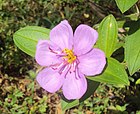Note: This is a project under development. The articles on this wiki are just being initiated and broadly incomplete. You can Help creating new pages.
Melastoma malabathricum
Melastoma malabathricum, known also as Malabar melastome, Indian rhododendron, Singapore rhododendron, planter's rhododendron and senduduk, is a flowering plant in the family Melastomataceae.
Contents
- 1 Uses
- 2 Parts Used
- 3 Chemical Composition
- 4 Common names
- 5 Properties
- 6 Habit
- 7 Identification
- 8 List of Ayurvedic medicine in which the herb is used
- 9 Where to get the saplings
- 10 Mode of Propagation
- 11 How to plant/cultivate
- 12 Commonly seen growing in areas
- 13 Photo Gallery
- 14 References
- 15 External Links
Uses
Treat diarrhoea, Dysentery,Hemorrhoids,cuts and wounds,toothache, and stomachache.
Parts Used
Chemical Composition
Various phytochemical groups and constituents have been identified in M. malabathricum since 1968 and are strongly associated with its ethnomedicinal values. [1]
Common names
| Language | Common name |
|---|---|
| Kannada | ಅಂಕೇರ್ಕಿ Ankerki, ದೊಡ್ಡ ನೆಕ್ಕರೆ Dodda nekkare |
| Hindi | |
| Malayalam | Kalathi,Kadali |
| Tamil | Katalai |
| Telugu | Nekkare, Nekkaresaelya |
| Marathi | Lakeri, Palore |
| Gujarathi | NA |
| Punjabi | NA |
| Kashmiri | NA |
| Sanskrit | Tinisah |
| English | Malabar Melastome, Indian-rhododendron |
Properties
Reference: Dravya - Substance, Rasa - Taste, Guna - Qualities, Veerya - Potency, Vipaka - Post-digesion effect, Karma - Pharmacological activity, Prabhava - Therepeutics.
Dravya
Rasa
Guna
Veerya
Vipaka
Karma
Prabhava
Habit
Identification
Leaf
| Kind | Shape | Feature |
|---|---|---|
| Simple | Alternate | The leaves are light green and feathery with a bipinnate pattern |
Flower
| Type | Size | Color and composition | Stamen | More information |
|---|---|---|---|---|
| Unisexual | 1 inch | Light blue | 5 | Flowers Season is June - August |
Other features
List of Ayurvedic medicine in which the herb is used
- Vishatinduka Taila as root juice extract
Where to get the saplings
Mode of Propagation
How to plant/cultivate
Shrubs to 1.3 m tall; stem densely covered with paleaceous pectinate hairs. Leaves 4-11 x 1.5-4 cm, elliptic-oblong, base attenuate, apex acute, upper surface prominently lineolate; lower surface tomentose, 5-ribbed, drying dull-greenish; petiole to 1.5 cm long. Flowers solitary or few in rather dense clusters, c. 5 cm across; bracts 1.2-2 x 1-1.4 cm, boat-shaped, densely paleaceous hairy. Calyx tube 0.7-1 cm long, campanulate; lobes 5, 5-7 x 4-5 mm, ovate-lanceolate, densely paleaceous hairy. Petals 5, reddish purple, 1.5-2 x 0.7 - 1 cm, obovate. Stamens 10, alternating ones large and small; anthers dimorphic, dehiscence by apical pores. Ovary ovoid, 5-locular; ovules many; style simple. Capsules 1-1.5 x 0.8-1 cm, ovoid, irregularly dehiscent. Seeds many, minute. [4]
Commonly seen growing in areas
Photo Gallery
References
External Links
- Ayurvedic Herbs known to be helpful to treat Treat diarrhoea
- Ayurvedic Herbs known to be helpful to treat Dysentery
- Ayurvedic Herbs known to be helpful to treat Hemorrhoids
- Ayurvedic Herbs known to be helpful to treat cuts and wounds
- Ayurvedic Herbs known to be helpful to treat toothache, and stomachache
- Herbs with Leaves used in medicine
- Herbs with Shoots used in medicine
- Herbs with Barks used in medicine
- Herbs with Seeds used in medicine
- Herbs with common name in Kannada
- Herbs with common name in Malayalam
- Herbs with common name in Tamil
- Herbs with common name in Telugu
- Herbs with common name in Marathi
- Herbs with common name in Sanskrit
- Herbs with common name in English
- Habit - Herb
- Index of Plants which can be propagated by roots
- Herbs that are commonly seen in the region of Tall grasslands
- Herbs that are commonly seen in the region of Meadows
- Herbs



